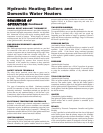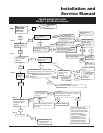
Hydronic Heating Boilers and
Domestic Water Heaters
SEQUENCE OF
OPERATION Continued
MANUAL RESET HIGH-LIMIT THERMOSTAT
A manual reset high limit thermostat is provided as backup for
the electronic adjustable temperature controller. An adjustable
dial thermostat will trip and require resetting should water
temperature exceed its settings. When tripped, all controls
remain powered, but 24VAC is prevented from being delivered
to the ignition module’s thermostat input.
EMS/SEQUENCER/REMOTE AQUASTAT
TERMINALS
The EMS/sequencer/remote aquastat terminals are provided
for connection of the unit to an external energy management
system or sequencer and are located along the top edge of the
terminal strip located within the electrical wiring box. In
addition to providing a means to externally stage fire the unit,
these terminals also provide for remote shutdown and override
by routing through dry contacts from external devices.
Connection of the external dry contacts to these terminals
requires the removal of one or more factory installed jumpers
located on the terminal strip.
SAFETY DEVICE TERMINALS
The safety device terminals ensure that no power can be
delivered to the ignition module unless factory/field-installed
safety devices such as flow switches and gas pressure switches
are closed. These safety device terminals are located below
the EMS/Sequencer/Remote Aquastat terminals located within
the electrical wiring box.
Two types of connections are offered: Continuous terminals
provide for connection of safety devices that are desired to be
constantly monitored. Intermittent terminals are provided for
devices that are only monitored during a “call for heat” cycle.
Connection to either of these terminals requires the removal of a
factory-installed jumper located on the terminal strip.
ELECTRONIC TEMPERATURE CONTROLLER
(Operator) A multiple stage electronic temperature controller is
provided on the unit and it serves to maintain a user selectable
temperature set point. In addition to maintaining a set point, it can
provide for various desired modes of operation. Ultimately, the
temperature controller delivers 24VAC to the ignition module and
pressure switch when it senses heat mode is desired.
IGNITION MODULE
(Controlled by Electronic Temperature Controller)
Upon sensing the 24VAC delivered to the ignition module by the
electronic controller, the ignition modules check for a shorted
pressure switch and then, provided the air switch isn’t shorted,
supplies 120VAC to its blower output relay and waits for a
pressure switch signal.
TWO SPEED BLOWER(S)
(Controlled by Ignition Module and Relay Board)
Two-speed blower(s) serve to provide combustion air to the unit.
The blower is provided with a high and low speed tap.
Depending upon the number of stages in operation, a blower’s
speed may increase or decrease accordingly. Stage 2 will increase
the blower’s speed to high.
PRESSURE SWITCH
(Activated by Blower Turning On)
One pressure switch is provided per blower to monitor its on/off
operation. Upon a call for heat, 24VAC is delivered to the
pressure switch. If the blower being monitored generates
adequate air pressure, the pressure switch closes to deliver 24VAC
to their respective ignition module’s pressure switch monitoring
input terminal.
PREPURGE
(Ignition Module Function)
Once an ignition module sees a 24VAC input from its pressure
switch, it runs the blowers for approximately 15 seconds in order
to purge the combustion chamber of any unburned fuel/air
mixture.
TRIAL FOR IGNITION
(Ignition Module Function)
Once an ignition module has completed its prepurge period, it
turns on a hot surface igniter. Once the hot surface igniter’s
current draw reaches a proper level, the ignition module begins a
trial for ignition period of approximately 25 seconds to allow time
for the igniter to reach the ignition temperature necessary to ignite
the fuel/air mixture.
IGNITER
(Controlled by Ignition Module)
One igniter per ignition module is provided in order to ignite the
fuel/air mixture and its on/off operation is controlled by the
ignition module.
RELAYS
(Controlled by Electronic Temperature Controller and Ignition
Module)
A relay is provided to switch each blower from low to high speed
and to deliver power from the primary stages to the secondary
stages depending upon the electronic thermostat’s settings. The
relay also serves to override the pressure switch proving function
of the second ignition control (if equipped) to activate during a
call for heat because both blowers run whenever any or all stages
60


















